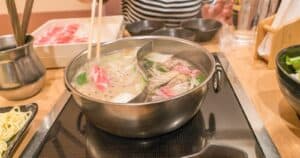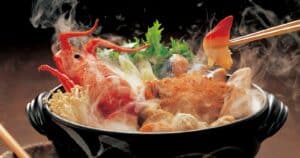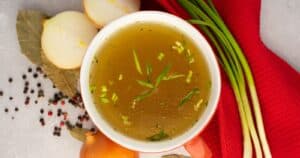As you gather around the bubbling broth filled with delicious ingredients, you savor the complex aromas and flavors, but have you ever wondered exactly what spices make hot pot so tasty?
With so many
Whether it’s the tongue-numbing heat of Sichuan peppercorns, the fresh zing of ginger and garlic, or the exotic twist of star anise and clove, spices transform hot pot from a basic soup to a sensory experience.
Understanding the spices used in different hot pot traditions allows you to create authentic flavor profiles or experiment with your own fusion. While recipes vary, most hot pots include warming aromatics like chili peppers, robust alliums like onions and scallions, and earthy spices like cumin and coriander.
Let’s uncover the intoxicating
Why Spices Are Key to Hot Pot
Before diving into specific spices, let’s look at why they are so integral to hot pot:
- Layered flavor – Spices add complexity and depth to simple broths and ingredients
- Regional authenticity – Certain
spice blends define the signature flavors of Sichuan, Thai, Japanese, Korean and Mongolian hot pot - Health benefits – Many spices contain antioxidants, anti-inflammatory and anti-bacterial properties
- Aromatics – Warming spices infuse hot pots with tempting aromas
- Heat – Chili peppers, Sichuan peppercorns, and mustard seed provide tongue-tingling heat
- Seasoning – Spices enhance and balance flavors instead of just making food taste hot
10 Essential Hot Pot Spices
Here are the top spices used across the major styles of hot pot:
Sichuan Peppercorns
The key
Dried Chilies
Various types of dried red chilies provide spicy heat, like cayenne, Arbol, and Tien Tsin.
Garlic
Pungent, aromatic garlic flavors the broth and offers health benefits. Often minced or crushed.
Ginger
Fresh ginger adds a bright, zesty punch. It aids digestion too. Better minced than sliced.
Scallions
Scallions lend fresh onion flavor. Both the white and green parts flavor hot pots.
Star Anise
With an assertive licorice taste, these dried pods add exotic flavor to Chinese hot pots.
Cinnamon
A warming
Fennel Seeds
Provide an anise-like sweetness and faint licorice flavor to many Asian hot pots.
Cardamom
Intensely aromatic, these pods join cumin and coriander in Indian-style hot pots.
Galangal
Resembling ginger, galangal has piney, citrusy flavor. Used in Thai recipes like Tom Yum hot pot.
Spice Blends by Hot Pot Origin
Now let’s look at popular
Chinese Hot Pot
- Sichuan peppercorns
- Star anise
- Cinnamon
- Dried chilies
- Garlic, ginger
- Scallions
- Soy sauce
Thai Hot Pot (Tom Yum)
- Galangal
- Lemongrass
- Kaffir lime leaves
- Bird’s eye chilies
- Lime juice
- Cilantro
- Fish sauce
Japanese Hot Pot (Shabu Shabu)
- Ginger
- Scallions
- Dashi stock
- Sesame oil
- Ponzu
- Soy sauce
Korean Hot Pot (Sul Lung Tang)
- Gochugaru flakes
- Sesame oil
- Soy sauce
- Garlic, scallions
- Beef bone broth
Mongolian Hot Pot
- Cumin
- Coriander
- Fennel seeds
- Cayenne powder
- Cinnamon, star anise
- garlic, ginger
- Scallions
Tips for Using Spices in Hot Pots
- Buy spices whole instead of ground when possible for freshness
- Toast spices briefly to intensify flavor
- Add aromatics like garlic, ginger, scallions at the end so they don’t burn
- Adjust amounts to preference – add more heat or layer in complexity
- Consider
spice bags or strainers if concerned about grittiness - Let broth simmer at least 15 minutes for flavors to develop
Balancing Flavors with Spices
- Heat: chili peppers, Szechuan pepper, mustard seeds
- Sweet: cinnamon, cloves, cumin
- Savory: garlic, onion, broth concentrates
- Bitter: Fenugreek, citrus rinds
- Aromatic: ginger, lemongrass, galangal
Flavor Profile by Hot Pot Type
Sichuan – Lip numbing heat, warm aromatics
Thai – Zesty, sour, and spicy
Japanese – Clean, dashi umami with sesame
Korean – Savory beef and fermented heat
Mongolian – Warming whole spices and chilies
Hot Pot Spice Combinations to Try
Moroccan – Ras el hanout
Indian – Garam masala, cumin, coriander, cardamom, turmeric
Cajun – Cayenne, paprika, oregano, thyme, bay leaf
Jamaican – Jerk seasoning, allspice, habanero, nutmeg, lime
Vietnamese – Lemongrass, chilies, shrimp paste, basil, lime
Storing Spices Properly
- Keep in airtight containers away from light, heat, and moisture
- Don’t store near oven or fridge, which are too humid
- Transfer spices from plastic bags into jars or tins
- Buy whole spices whenever possible and grind as needed
- Mark purchase date on containers and use within 1-2 years
- Smell spices periodically and replace if aroma fades
Ready, Set, Spice !
The beauty of hot pot is that while traditions exist, there’s also room for creativity. Now that you know the flavor foundations, you can start experimenting with your own





